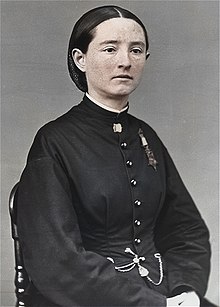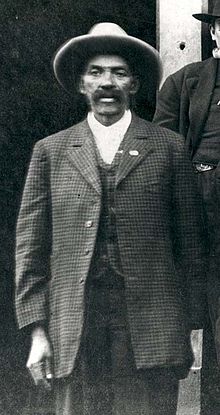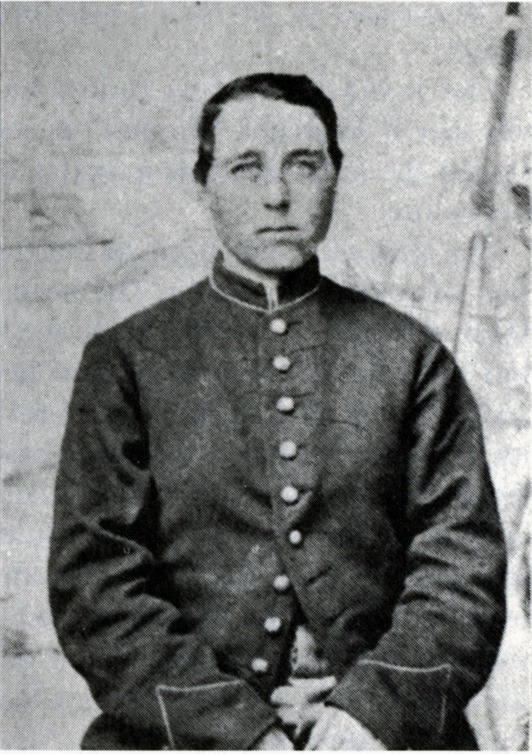Dr. Mary Walker was a remarkable woman. She was one of the first female doctors in the United States, and served as an army surgeon on the front lines during the Civil War. A dedicated reformer, Mary advocated for universal suffrage, abolition, dress reform, and temperance. She organized a relief system for the wives of wounded soldiers, and wrote two books. She remains, to this day, the only woman to have won the Medal of Honor.
 Mary was born in Oswego New York on November 26, 1832 to the unusual Alvah and Vesta Walker. (Alvah is the father.) Mary was the youngest of seven children--six girls and one boy. Mary's parents were eccentric for the times. They believed in sharing the work equally, and Alvah could often be found doing household chores. They allowed their daughters to dress however they liked, not forcing them into the restraining corsets and long skirts of the time, which both rightfully believed squished a girl's internal organs. To cap off the unusual Walker family, their home was also a stop on the Underground Railroad.
Mary was born in Oswego New York on November 26, 1832 to the unusual Alvah and Vesta Walker. (Alvah is the father.) Mary was the youngest of seven children--six girls and one boy. Mary's parents were eccentric for the times. They believed in sharing the work equally, and Alvah could often be found doing household chores. They allowed their daughters to dress however they liked, not forcing them into the restraining corsets and long skirts of the time, which both rightfully believed squished a girl's internal organs. To cap off the unusual Walker family, their home was also a stop on the Underground Railroad.
Alvah had an interest in medicine, and a sizeable library of medical texts. Alvah and Vesta encouraged Mary to read as many of the medical books as she liked. Both of the Walkers were big believers in education, with Vesta being a school teacher. All of their children were educated through primary school, and all of the daughters went into teaching at one point in their lives.
Mary worked briefly as a teacher, and in 1855 she entered and graduated Syracuse Medical School. Her course at Syracuse was only 39 weeks--three semesters of thirteen weeks each, which seems an almost irresponsible amount of training to give a doctor today, but was standard for the time. Mary chose Syracuse because it admitted women, and because it was known for its non-quackery. In an era where bloodletting and leeches were still common practices, Syracuse focused on more homeopathic remedies, and modern innovations.
After graduation she married her classmate Albert Miller in an unusual ceremony where the bride wore pants, struck the 'obey' clause from her vows, and refused to take her husband's last name. Mary and Albert set up a practice together, and seemed to have been quite successful, with Mary treating the women and children, and Albert the men. Mary began to write about dress reform, and to present medical evidence in favor of this at important conferences. However, in 1859 this all ground to a halt when Mary discovered that Albert had been cheating on her. Mary tossed Albert out, and travelled to Iowa, where it was easier for women to obtain a divorce. Though it took several years, Mary eventually divorced Albert, and began life anew.
After the First Battle of Bull Run, Mary decided to join the Union Army Medical Corp. She had nothing tying her down--Albert was long gone, her solo practice was a bust, and she had no children. Mary believed that she had a lot to offer as an army surgeon, so she went to Washington DC to ask for a commision.
Unfortunately, the Union Army wasn't accepting female surgeons, or female anything really. Frustrated, Mary decided not to let a lack of pay stop her from doing what she wanted. She instead started volunteering as a nurse at the Patent Office Hospital, working under Dr. J.N. Green. Sources differ about what happened at this point. Some sources say that Dr. Green desperately need an assistant surgeon, and Mary filled that role. Others say that she did basically everything but surgery--dressing wounds, running errands, and entertaining patients. Whatever she did, Mary impressed Dr. Green so much that he recommend that she be given a commission.
This recommendation was, of course, ignored, and Mary briefly went back to medical school in order to boost her credentials. She graduated from Hygeia Therapeutic College, and started volunteering in hospitals up and down Virginia.
Mary was very outspoken about her opinions on how the war should be run. She published editorials suggesting that, in order to boost flagging enlistment numbers, former criminals could be enlisted, and even offered to serve as their surgeon. This gained the attention of war secretary, Edwin M. Stanton, who was definitely not going to create a regiment of former felons, and definitely didn't appreciate a lady having ideas. He gave Mary a posting, if not a commission or salary, to serve as an assistant surgeon with the 52nd Ohio Regiment in Tennessee.
This was on the front lines, and there Mary faced a bit of difficulty. Wandering around a battlefield in skirts and petticoats was a terrible idea, and Mary had never been fond of dressing in typical Antebellum clothing anyways. In fact, she had been arrested several times for dressing like a man, and was frequently harassed for wearing a bloomer costume. On the front lines, Mary abandoned all pretense of dressing like a woman, instead donning a uniform, and making herself a green sash that denoted her as a member of the medical corp.
Mary caused a bit of trouble with the 52nd with her, then, unconventional medical practices. An opponent of amputation, Mary felt that surgeons often rushed the decision to amputate, and that most wounds would be better treated by homeopathic remedies (like bandages and medicines) then amputation. When the male surgeons wouldn't listen to her, she talked directly to the patients, urging them to refuse amputation.
Unsurprisingly, Mary faced a great deal of misogyny with the Ohio 52nd. Though her commanding officer, George H. Thomas, didn't care that she was female, the male surgeons cared very much. They didn't believe that she was capable of performing her duties as a surgeon, and even arranged a medical 'review' for her skills, which they then failed her on. Despite this, Mary refused to resign, and her commanding officer did not dismiss her. When the other surgeons refused to give her patients, Mary turned to treating civilians.
Deep in Rebel territory, Mary was treating the wives and children of Confederate soldiers, many of whom were in hiding from the Union army. She is reputed to have taken supplies from Union stores in order to treat the unfortunates displaced by the war. It was during this time in 1864 that she was captured by the Confederacy.
Now, there is some debate as to why Mary was captured. Some sources claim that it was because she was wearing men's clothing while being a Union soldiers, but other sources, including US Government Agencies, claim that it was because she was spying for the Union. In 1865 a federal judge put on the record that Mary had been a spy for General Sherman's army. Despite this record, there's some debate over whether or not Mary was up to espionage. However, this historian would like to posit that, while treating Confederate civilians, Mary would have several excellent opportunities for intelligence gathering.
After being captured, Mary was sent to Castle Thunder Prison in Richmond. Castle Thunder was nicknamed 'the Southern Bastille', and not without reason. While in prison, Mary was treated abysmally. She was given only moldy bread and maggot ridden rice. She contracted bronchitis, lost an unhealthy amount of weight, and had to deal with fleas and bedbugs. Her eyesight was permanently damaged by the gas burning lamps in the prison. She would remain at Castle Thunder for four months.
After being released Mary was celebrated far and wide for her heroics in war, even meeting President Lincoln. Edwin Stanton still denied her request for a commission, but she was given $432.26 in backpay, and was officially put on the US Army payroll. She was dispatched first to a women's military prison, then to an orphanage. When the Civil War ended in 1865 Mary was discharged from the army.
Even after being discharged, Mary continued to lobby for a commision. President Andrew Johnson was in favor of this promotion, but military officials refused to give Mary a commision, fearing that if they gave one woman a commision, all the women would want commissions. Instead, President Johnson gave Mary the Congressional Medal of Honor, making her the only woman to this day to be awarded the honor.
After being discharged, Mary took up work as an activist and reformer. She had some experience with this, having run a relief society for the mother's of wounded soldiers during her time at the Patent Office Hospital. Unaccompanied women who had come to see their wounded sons or husbands were rarely able to find lodging, and Mary organized a society that arranged places for those women to stay. She also, on several occasions, went over enemy lines to retrieve wounded sons or husbands for distraught women.
Upon realizing that the many nurses who had served during the war had received no pay during the war, or pension after, Mary took up their cause, and by 1872 had browbeat Congress into giving the nurses a pension of $20 a month, despite the fact that she herself would not be successful in getting a pension for another two years.
Mary was also active in the suffrage movement, specifically in the area of dress reform. She was arrested several times before and after the war for wearing men's clothing, and was quite proud of the fact. She gave lectures about the negative health effects of constrictive clothing. Because of this she was quite controversial, and other suffragettes didn't want her associated with the cause.
Mary also took up her pen, publishing two books, Hit in 1871, and Unmasked: or the Science of Immorality in 1878. Both books argue for equality in a marriage, and for temperance and universal suffrage, but it is in Unmasked where Mary really hits hard. In a book as bitingly relevant today as it was when it was written, Mary puts forth the theory that if women could control their sexual urges, men could too. She argues that marriage should be a contract between social equals, and that just because a couple was married didn't mean they were allowed to rape each other.
In 1874, Mary was finally given a pension of $8.50 a month. However, in 1917, her Medal of Honor was rescinded in an act of congress that took medals away from 911 individuals. The reasoning behind this was that the Medal of Honor could only be earned if the wearer had served in combat, which Mary hadn't. Continuing to wear the medal was a misdemeanor, but when a soldier came for her medal, Mary told him that he could take it over her dead body. She wore her award every day until her death.
In 1880 Alvah Walker passed, leaving Mary his farm. Mary spent the rest of her life there, traveling between New York and Washington DC, lecturing and agitating for change. In 1919 she had a fall on the steps of the US Capitol, and died shortly after.
After her death, her family crusaded tirelessly to have her Medal of Honor restored. In 1977, they were successful, and Mary's medal was officially restored to her by President Jimmy Carter. Today, it is on display in the Pentagon.
Sources
Amazing Women of the Civil War: Fascinating True Stories of Women Who Made a Difference by Webb Garrison
Women of the Blue and Grey by Marianne Monson
Mary Walker-National Parks Service
Meet Dr. Mary Walker--the Only Female Medal of Honor Recipient
Dr. Mary E. Walker
Dr. Mary Edwards Walker
Dr. Mary Walker and the Medal of Honor
Mary Walker-Biography
Mary Edwards Walker
Mary Edwards Walker: Doctor American Civil War Women
 Mary was born in Oswego New York on November 26, 1832 to the unusual Alvah and Vesta Walker. (Alvah is the father.) Mary was the youngest of seven children--six girls and one boy. Mary's parents were eccentric for the times. They believed in sharing the work equally, and Alvah could often be found doing household chores. They allowed their daughters to dress however they liked, not forcing them into the restraining corsets and long skirts of the time, which both rightfully believed squished a girl's internal organs. To cap off the unusual Walker family, their home was also a stop on the Underground Railroad.
Mary was born in Oswego New York on November 26, 1832 to the unusual Alvah and Vesta Walker. (Alvah is the father.) Mary was the youngest of seven children--six girls and one boy. Mary's parents were eccentric for the times. They believed in sharing the work equally, and Alvah could often be found doing household chores. They allowed their daughters to dress however they liked, not forcing them into the restraining corsets and long skirts of the time, which both rightfully believed squished a girl's internal organs. To cap off the unusual Walker family, their home was also a stop on the Underground Railroad.Alvah had an interest in medicine, and a sizeable library of medical texts. Alvah and Vesta encouraged Mary to read as many of the medical books as she liked. Both of the Walkers were big believers in education, with Vesta being a school teacher. All of their children were educated through primary school, and all of the daughters went into teaching at one point in their lives.
Mary worked briefly as a teacher, and in 1855 she entered and graduated Syracuse Medical School. Her course at Syracuse was only 39 weeks--three semesters of thirteen weeks each, which seems an almost irresponsible amount of training to give a doctor today, but was standard for the time. Mary chose Syracuse because it admitted women, and because it was known for its non-quackery. In an era where bloodletting and leeches were still common practices, Syracuse focused on more homeopathic remedies, and modern innovations.
After graduation she married her classmate Albert Miller in an unusual ceremony where the bride wore pants, struck the 'obey' clause from her vows, and refused to take her husband's last name. Mary and Albert set up a practice together, and seemed to have been quite successful, with Mary treating the women and children, and Albert the men. Mary began to write about dress reform, and to present medical evidence in favor of this at important conferences. However, in 1859 this all ground to a halt when Mary discovered that Albert had been cheating on her. Mary tossed Albert out, and travelled to Iowa, where it was easier for women to obtain a divorce. Though it took several years, Mary eventually divorced Albert, and began life anew.
| Mary, wearing her controversial bloomers costume. |
Unfortunately, the Union Army wasn't accepting female surgeons, or female anything really. Frustrated, Mary decided not to let a lack of pay stop her from doing what she wanted. She instead started volunteering as a nurse at the Patent Office Hospital, working under Dr. J.N. Green. Sources differ about what happened at this point. Some sources say that Dr. Green desperately need an assistant surgeon, and Mary filled that role. Others say that she did basically everything but surgery--dressing wounds, running errands, and entertaining patients. Whatever she did, Mary impressed Dr. Green so much that he recommend that she be given a commission.
This recommendation was, of course, ignored, and Mary briefly went back to medical school in order to boost her credentials. She graduated from Hygeia Therapeutic College, and started volunteering in hospitals up and down Virginia.
Mary was very outspoken about her opinions on how the war should be run. She published editorials suggesting that, in order to boost flagging enlistment numbers, former criminals could be enlisted, and even offered to serve as their surgeon. This gained the attention of war secretary, Edwin M. Stanton, who was definitely not going to create a regiment of former felons, and definitely didn't appreciate a lady having ideas. He gave Mary a posting, if not a commission or salary, to serve as an assistant surgeon with the 52nd Ohio Regiment in Tennessee.
This was on the front lines, and there Mary faced a bit of difficulty. Wandering around a battlefield in skirts and petticoats was a terrible idea, and Mary had never been fond of dressing in typical Antebellum clothing anyways. In fact, she had been arrested several times for dressing like a man, and was frequently harassed for wearing a bloomer costume. On the front lines, Mary abandoned all pretense of dressing like a woman, instead donning a uniform, and making herself a green sash that denoted her as a member of the medical corp.
Mary caused a bit of trouble with the 52nd with her, then, unconventional medical practices. An opponent of amputation, Mary felt that surgeons often rushed the decision to amputate, and that most wounds would be better treated by homeopathic remedies (like bandages and medicines) then amputation. When the male surgeons wouldn't listen to her, she talked directly to the patients, urging them to refuse amputation.
 |
| In her later years, Mary almost exclusively wore men's clothing. |
Deep in Rebel territory, Mary was treating the wives and children of Confederate soldiers, many of whom were in hiding from the Union army. She is reputed to have taken supplies from Union stores in order to treat the unfortunates displaced by the war. It was during this time in 1864 that she was captured by the Confederacy.
Now, there is some debate as to why Mary was captured. Some sources claim that it was because she was wearing men's clothing while being a Union soldiers, but other sources, including US Government Agencies, claim that it was because she was spying for the Union. In 1865 a federal judge put on the record that Mary had been a spy for General Sherman's army. Despite this record, there's some debate over whether or not Mary was up to espionage. However, this historian would like to posit that, while treating Confederate civilians, Mary would have several excellent opportunities for intelligence gathering.
After being captured, Mary was sent to Castle Thunder Prison in Richmond. Castle Thunder was nicknamed 'the Southern Bastille', and not without reason. While in prison, Mary was treated abysmally. She was given only moldy bread and maggot ridden rice. She contracted bronchitis, lost an unhealthy amount of weight, and had to deal with fleas and bedbugs. Her eyesight was permanently damaged by the gas burning lamps in the prison. She would remain at Castle Thunder for four months.
After being released Mary was celebrated far and wide for her heroics in war, even meeting President Lincoln. Edwin Stanton still denied her request for a commission, but she was given $432.26 in backpay, and was officially put on the US Army payroll. She was dispatched first to a women's military prison, then to an orphanage. When the Civil War ended in 1865 Mary was discharged from the army.
 |
| Mary's habit of wearing a top hat did not endear her to the rest of the suffragettes. |
After being discharged, Mary took up work as an activist and reformer. She had some experience with this, having run a relief society for the mother's of wounded soldiers during her time at the Patent Office Hospital. Unaccompanied women who had come to see their wounded sons or husbands were rarely able to find lodging, and Mary organized a society that arranged places for those women to stay. She also, on several occasions, went over enemy lines to retrieve wounded sons or husbands for distraught women.
Upon realizing that the many nurses who had served during the war had received no pay during the war, or pension after, Mary took up their cause, and by 1872 had browbeat Congress into giving the nurses a pension of $20 a month, despite the fact that she herself would not be successful in getting a pension for another two years.
Mary was also active in the suffrage movement, specifically in the area of dress reform. She was arrested several times before and after the war for wearing men's clothing, and was quite proud of the fact. She gave lectures about the negative health effects of constrictive clothing. Because of this she was quite controversial, and other suffragettes didn't want her associated with the cause.
 |
| Mary's Medal of Honor |
In 1874, Mary was finally given a pension of $8.50 a month. However, in 1917, her Medal of Honor was rescinded in an act of congress that took medals away from 911 individuals. The reasoning behind this was that the Medal of Honor could only be earned if the wearer had served in combat, which Mary hadn't. Continuing to wear the medal was a misdemeanor, but when a soldier came for her medal, Mary told him that he could take it over her dead body. She wore her award every day until her death.
In 1880 Alvah Walker passed, leaving Mary his farm. Mary spent the rest of her life there, traveling between New York and Washington DC, lecturing and agitating for change. In 1919 she had a fall on the steps of the US Capitol, and died shortly after.
After her death, her family crusaded tirelessly to have her Medal of Honor restored. In 1977, they were successful, and Mary's medal was officially restored to her by President Jimmy Carter. Today, it is on display in the Pentagon.
Sources
Amazing Women of the Civil War: Fascinating True Stories of Women Who Made a Difference by Webb Garrison
Women of the Blue and Grey by Marianne Monson
Mary Walker-National Parks Service
Meet Dr. Mary Walker--the Only Female Medal of Honor Recipient
Dr. Mary E. Walker
Dr. Mary Edwards Walker
Dr. Mary Walker and the Medal of Honor
Mary Walker-Biography
Mary Edwards Walker
Mary Edwards Walker: Doctor American Civil War Women







